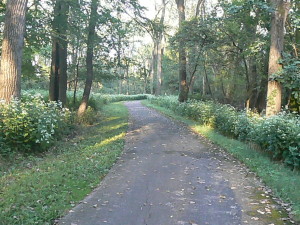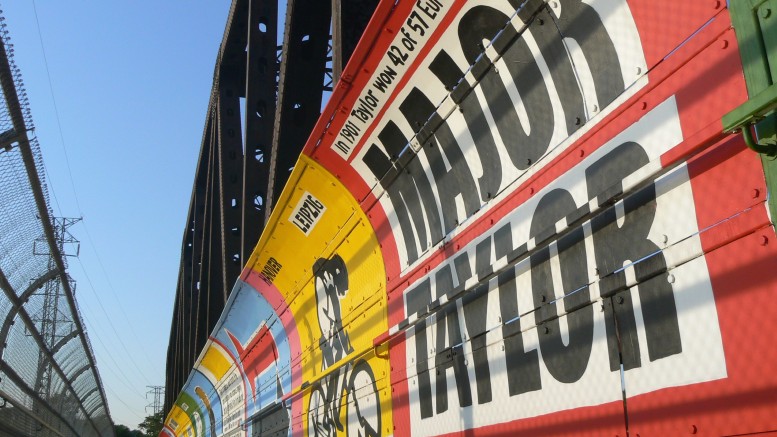Since the the City of Chicago actively promotes biking using its DIVVY bike share program and constantly gobbles up roads to make way for protected bike lanes, here is a reason why more Blacks should get into the sport of cycling and make tracks on two-wheels instead four. I reached back into the annals of my career as a community journalist to discover this hidden gem of a story. Originally published in the Citizen Newspapers in 2007.
by La Risa Lynch
It took nearly 10 years, but a seven-mile bike path named after cycling’s first international Black sports star was officially dedicated last Saturday in the West Pullman community.
The Major Taylor Bike Trail snakes its way from the Dan Ryan Woods near 83rd Street following an old abandoned railway before ending in picturesque Whistler Woods in suburban Riverdale.
Cycling enthusiasts, residents, and city and Chicago Park District officials gathered at the trail’s halfway point near 111th and Aberdeen for the dedication. But many praised the tenacity of the man for whom the trail is named after, Marshall “Major” Taylor, an Indiana native, born in 1878, who excelled at a sport not particularly associated with Blacks — bicycle racing.
“To name it after someone who was the first African-American cyclist was important for me,” said Ald. Carrie Austin (34) whose ward has the longest portion of the trail running through it. She first became of Major Taylor during an early planning meeting for the trail in the late 1990s when a park district commissioner handed her Taylor’s autobiography.
“She gave it to me as a present and I read it cover to cover. I was absolutely in awe that in 1899 an African-American was a top cyclist,” Austin said, noting that she had encountered some resistance to naming the trail after Taylor. “I didn’t care what anybody wanted to name it. It had no other name.”
The trail is living Black History that could inspire more Black to take up the cycling or learn about Major Taylor, Austin added.
“Maybe this and educating the community about his history will spark some young cyclist in the community to pick up where he left off,” said Michelle Jones, of the Chicago Park District.
Major Taylor rose to prominence in the sport of cycling that was dominated by whites. He endured the sting of racism to not only beat white American cyclists, but European cyclists as well, becoming the first international known Black athlete.
Long before Jackie Robinson broke the colored barrier in baseball, a then 19-year-old Taylor was a world champion bicycle racer in 1899. He became only the second Black world champion athlete after bantamweight boxer George Dixon’s title fights in 1890-91, and before that of boxing legend Jack Johnson.
“It was 1947 — that’s the date that Jackie Robinson broke the color barrier in baseball. That is suppose to be the number one celebrated thing in professional sports and in integration,” said Keith Holt, the Chicago Bike Federation’s community liaison. “But here we have Major Taylor born … right around the Civil War. This is a man whom we don’t hear about to much.”

Major Taylor Trail ends in the bucolic forest preserve of Whistler Woods on the city’s far south side. (photo by La Risa Lynch)
Cyclist Patric McCoy, 60, called Taylor the Michael Jordan of his time. But the Bronzeville resident also hopes that the trail will generate interest in other Blacks like Chicago’s founding father, Jean Baptiste Pointe Du Sable.
“It is interesting what he had accomplished during a time where there was so much prejudice,” said McCoy, who uses cycling as his only mode of transportation. “For him to become an international sports figure … that was just unheard of.”
While the dedication coincided with National Trails Day, the bike path was part Mayor Daley’s rails to trails initiative where abandon railways are converted into bike, walking or jogging paths. The Major Taylor Bike Trail was part of defunct Conrail Railroad Company. The Chicago Department of Transportation (CDOT) acquired the property in 1997-98 before transferring it over to the park district, which pledged to maintain the property. The trail is a combination of on-street routes with bike lanes and off street routes.
“We are proud of the Major Taylor Trail,” said CDOT Commissioner Cheri Heramb. “We think it is a great asset to the community. We are joyous to see all the people who are using it today and assembled to dedicate it to Major Taylor, a great American athlete.”
Besides the historical significance, the trail has several health benefits too. It can reduce the prevalence of obesity, diabetes and heat disease, said Peter Taylor, an avid cyclist and Roseland Heights resident.
“The use of the Major Taylor Trail by the community will strengthen their bodies and their minds., Taylor said, (no relation to Major Taylor.)
Several community groups including the Morgan Park Civic League plan to create an advisory council much like many neighborhood parks. Although in its initial stages the council’s goals is to see a mural started by an artist completed, to have sculpture garden along the trail and possibility cafes.
“For us we don’t have enough recreational paths,” said Paula Robinson, the league’s manager director. “We don’t have a lakefront, but we have an abandoned rail corridor that is now a fabulous trail, so we are pretty happy.”
Avid cyclist Harold Lucas, of the Bronzeville Visitor Center and Morgan Park Civic League, sees the trail as an economic stimulus for the far south side. The trail’s association connection to the rails to trails conservancy project and named after Major Taylor makes it a tourist attraction.
“It is important for the African-American community to step up and codify its assets to create destinations where we can generate wealth for our communities,” Lucas said.

Be the first to comment on "Major Taylor Bike Trail Officially Dedicated on South Side"